
Have you ever wanted to control Arduino projects using Python instead of learning C++? You're in the right place! While Arduino traditionally uses C++ like code, you can actually program and control Arduino boards using Python through a powerful protocol called Firmata. This comprehensive guide will show you exactly how to set up Python to communicate with Arduino, control LEDs and sensors, and build amazing projects without writing a single line of C++ code. Whether you're a Python developer looking to dive into hardware projects or a complete beginner who finds Python easier than C++, this tutorial covers everything you need to know about programming Arduino with Python using PyFirmata. This tutorial was last updated on May 2025 to test the code for the latest Arduino development boards, including the Arduino UNO R4.
If you are interested in programming microcontrollers using Python, you can also check out ESP32 Micropython tutorial and our Raspberry Pi Pico Micropython tutorial. And if you wanna go full pro with using Python in electronics projects, do check out our Raspberry Pi projects where we have built a done of cool stuff using Raspberry Pi boards and Python.
Can Arduino Be Programmed in Python? (Quick Answer)
Yes, you can program Arduino with Python using the PyFirmata library. While Arduino traditionally uses C++ code, Python can control Arduino boards through the Firmata protocol, allowing you to leverage Python's simplicity for hardware projects.
This comprehensive tutorial shows you exactly how to:
- Set up Python to communicate with Arduino UNO, but you can follow the same for any Arduino boards.
- Control LEDs, sensors, and servo motors using Python code
- Read analog and digital inputs with Python
- Build real Arduino projects without writing C++ code
It’s a cool idea, right?. So, without further delay, let’s explore this concept in more detail.
Table of Contents
- Can Arduino Be Programmed in Python? (Quick Answer)
- Program Arduino using Python?
- What is Firmata Protocol for Arduino Python Programming?
- How Does Firmata Work with Arduino and Python?
- Components Required
- Preparing Arduino UNO Board for Python Programming
- Installing PyFirmata for Arduino Python Programming
- Essential PyFirmata Functions for Arduino Python Control
- Digital Read:
- └ Python Code for Digital Read on Arduino
- Digital Write:
- └ Python Code for Arduino Digital Write:
- Analog Read:
- └ Python Code to read Analog Sensor on Arduino
- Analog Write or PWM Control:
- └ Python Code to Control the Brightness of LED using PWM
- Servo Motor Control:
- └ Python Code for Controlling Arduino Servo Motor
- Advantages of Using Firmata
- Arduino Python vs C++: Which Should You Choose?
- Disadvantages of Using Firmata
- Troubleshooting Common Arduino Python Issues
- Download Python Arduino Codes from Github
- Frequently Asked Questions
- Conclusion: Master Arduino Programming with Python
- Related Arduino Python Projects to Try Next
Program Arduino using Python?
As we already know, interacting with an Arduino board using Python is possible, but it requires a specific approach. This involves real-time programming, where our Python program communicates with the Arduino board. To achieve this, we need a wired or wireless connection between the Arduino board and the device running the Python program. This is where Firmata comes in. Of course, you can compete by bypassing Firmata and do simple serial communication between Arduino and Python to get stuff done, but Firmata just makes it so much easier and professional for scalable coding.
What is Firmata Protocol for Arduino Python Programming?
Firmata is a communication protocol used to connect microcontrollers, such as Arduino, with a computer. It allows you to control and interact with the microcontroller’s inputs and outputs directly from the software on your PC. Firmata is built on the MIDI message format, which can handle messages of varying lengths. However, this isn't an issue for Firmata and microcontrollers, as the amount of data transferred is usually minimal.
The key advantage of Firmata is that it has been implemented in multiple programming languages, including Python. This means you can use Firmata with different languages to communicate with your microcontroller, making it versatile and easy to integrate into various software environments. Here in this article, we will be focusing on Python.
So, let us know how it works!
How Does Firmata Work with Arduino and Python?
It’s really simple as the base architecture to implement Firmata already exists with the default Arduino IDE installation. Below you can see the steps to follow,
Installing the standard Firmata program on the Arduino board - thereby the Arduino board awaits the Firmata protocol via USB.
Including the PyFirmata library in your existing Python code - so, after including PyFirmata, we can start adding PyFirmata-dedicated functions to communicate with Arduino.
Completing the hardware setup - preparing the hardware with all the necessary circuit connections to ensure proper communication between the sensors, actuators, and PC while keeping the Arduino board in the middle.
In case you’d like to experience Firmata without writing a single line of code, there is software available for Windows users that can be used to explore the Firmata protocol with a simple, user-friendly UI.
The above image shows the user interface of Windows Remote Arduino Experience Software that you can download from the Microsoft store.
Components Required
As we are going to do some basic I/O practice, the components are going to be more straightforward.
Arduino UNO R3 Board x1
LED 5mm x1
Push Button x1
10K Potentiometer x1
SG90 Micro Servo Motor x1
Breadboard x1
Arduino Programming USB Cable x1
Resistor 330Ω, 10KΩ - each one nos
Connecting wires - Required Quantity
Preparing Arduino UNO Board for Python Programming
As I mentioned earlier, there is no need to write a single line of code on the Arduino side. There is a pre-built example for the Firmata protocol available in the Arduino IDE. In fact, there are several modes of connectivity available, like Bluetooth, WiFi, and more. I'll leave the rest for you to explore. So, enough talk—let's start programming now!
Above, you can see the image showing the Firmata library location. You can follow this location to open the standard Firmata program. Now, after selecting the appropriate port and board type, upload the program. That's it.
After a successful upload, things are done on the Arduino side. Next, we are going to play with Python.
Installing PyFirmata for Arduino Python Programming
As per our testing in 2025, PyFirmata works best with Python versions 3.8 to 3.11. While Python 3.12+ may work, we recommend Python 3.10 for the most stable experience. For the latest compatibility updates, always check the PyFirmata documentation.
Installing a supported version of Python: In my case, I installed Python 3.10.
Installing your preferred IDE: Using the direct Python IDLE should also work, but as a beginner, I recommend using PyCharm Community Edition.
Installing required packages: The only required package here is PyFirmata, and while installing PyFirmata, PySerial is also installed automatically.
Above, you can see the list of packages installed using the Package Manager in PyCharm.
Thereby, the installation of the required software is completed. Next, we can go on to programming the Arduino using Python.
Essential PyFirmata Functions for Arduino Python Control
There are five basic I/O operations that we can perform using PyFirmata:
Complete List of PyFirmata Arduino Control Methods
Digital Read
Digital Write
Analog Read
Analog Write or PWM Control
Servo Motor Control
Let's see all these in detail.
Digital Read:
Here, to perform the Digital Read using python on Arduino, I am going to connect a push button to pin 2 of the Arduino. This pin 2 is then pulled down using a 10k resistor to maintain a stable low state.
The above image shows the circuit diagram clearly. Once you complete the circuit diagram, connect the Arduino board to the computer using the USB cable. Next is the coding part.
Let's break down the code.
Step 1:
from pyfirmata import Arduino, utilThis line imports specific parts of the PyFirmata library, namely Arduino (to connect to the Arduino board) and util (which contains helpful tools like the Iterator).
Step 2:
board = Arduino('COM8')
This line establishes a connection between your computer and the Arduino board. 'COM8' is the port where the Arduino is connected. (On different computers, this might be a different port like COM3, COM4, etc., or /dev/ttyACM0 on Linux.)
Step 3:
button_pin = board.get_pin('d:2:i')This line sets up pin 2 on the Arduino as an input pin. Here's what the parameters mean:
'd' stands for "digital" (as opposed to analog).
'2' is the pin number on the Arduino.
'i' stands for "input," meaning this pin will receive signals (like the button being pressed).
Step 4:
it = util.Iterator(board)
it.start()it = util.Iterator(board): creates an Iterator object that will keep checking the state of the pins on the Arduino.
it.start(): starts the Iterator. Without it, the script wouldn't be able to continuously read the state of the button.
Step 5:
button_state = button_pin.read()“button_pin.read()” reads the state of the button and stores in “button_state”. The state can be:
True (if the button is pressed),
False (if the button is not pressed),
None (if the state is unknown or if the pin hasn’t been initialized yet).
Step 6:
board.exit()This safely closes the connection to the Arduino, ensuring that all resources are freed and the Arduino is ready for the next use.
Python Code for Digital Read on Arduino
from pyfirmata import Arduino, util
import time
# Replace 'COM8' with your Arduino port
board = Arduino('COM8') # Establish a connection to the Arduino board
# Set up digital pin 2 as an input pin for the button
button_pin = board.get_pin('d:2:i') # 'd' stands for digital, '2' is the pin number, 'i' is for input
# Start the iterator to continuously read and update pin states
it = util.Iterator(board)
it.start()
try:
while True:
button_state = button_pin.read() # Read the state of the button (True, False, or None)
print(f"Button state: {button_state}") # Print the current button state to the console
time.sleep(1) # Wait for 1 second before reading the button state again
except KeyboardInterrupt:
print("Program interrupted by user.") # Print a message if the program is interrupted
finally:
board.exit() # Safely exit and close the connection to the ArduinoIf you run this Python script, the output you get will look like below GIF Video.
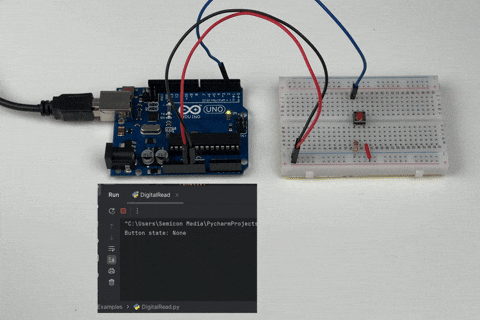
Digital Write:
We will be using a simple LED to demonstrate how we can do digital write on python for Arduino . We will connect an LED to pin 3 of the Arduino. The pin 3 is used as an output pin to control the LED. The LED is connected in series with a current-limiting resistor to prevent excessive current from damaging the LED.
The above image shows the circuit diagram clearly. After completing the circuit, connect the Arduino board to your computer using a USB cable. Now, let's move on to the coding part.
Let's break down the code while skipping the similar parts.
1. Setting up the LED
led_pin = board.get_pin('d:3:o')led_pin = board.get_pin('d:3:o'): Sets up pin 3 on the Arduino as an output pin. The parameters mean:
'd' stands for "digital" (as opposed to analog).
'3' is the pin number on the Arduino.
'o' stands for "output," meaning this pin will send signals (like turning the LED on or off).
2. Main Loop
while True:
led_pin.write(1) # Turn LED on
time.sleep(1) # Wait for 1 second
led_pin.write(0) # Turn LED off
time.sleep(1) # Wait for 1 secondwhile True: Creates an infinite loop, making the LED blink repeatedly.
led_pin.write(1): Turns the LED on by sending a signal to pin 3.
time.sleep(1): Pauses the program for 1 second before the next action.
led_pin.write(0): Turns the LED off.
time.sleep(1): Pauses the program for another 1 second, completing the blink cycle.
Python Code for Arduino Digital Write:
from pyfirmata import Arduino, util
import time
# Replace 'COM8' with your Arduino port
board = Arduino('COM8')
# Set up digital pin 3 as an output pin for the LED
led_pin = board.get_pin('d:3:o')
# Start the iterator to continuously read and update pin states
it = util.Iterator(board)
it.start()
try:
while True:
led_pin.write(1) # Turn LED on
time.sleep(1) # Wait for 1 second
led_pin.write(0) # Turn LED off
time.sleep(1) # Wait for 1 second
except KeyboardInterrupt:
print("Program interrupted by user.") # Print a message when interrupted
finally:
board.exit() # Safely exit and close the connection to the ArduinoIf you run this Python script, the output will be an LED that blinks on and off every second.
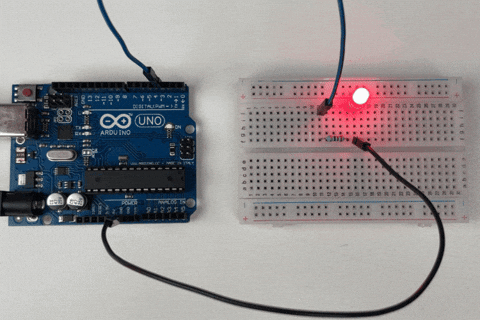
Analog Read:
For reading analog sensor on arduino using python, we'll connect an analog sensor (such as a potentiometer or temperature sensor) to the Arduino on analog pin A0. The sensor will output a variable voltage that the Arduino will read and process as an analog input.
The circuit diagram above provides a clear illustration of how to connect your sensor to the Arduino. After wiring the circuit, connect the Arduino board to your computer using a USB cable. Now, let's move on to the coding aspect.
Let's break down the key parts of the code.
1. Setting Up the Sensor:
sensor_pin = board.get_pin('a:0:i')Configures analog pin A0 on the Arduino as an input pin.
'a' stands for "analog."
'0' is the analog pin number.
'i' stands for "input," indicating that this pin will receive signals from the sensor.
2. Main Loop:
while True:
# Read the current sensor value from analog pin A0
sensor_value = sensor_pin.read()
# Print the sensor value to the console
print(f"Sensor value: {sensor_value}")
# Wait for 1 second before the next reading
time.sleep(1)sensor_pin.read(): Reads the current value from the analog sensor connected to pin A0. The value is typically between 0 (0V) and 1 (5V).
print(f"Sensor value: {sensor_value}"): Displays the sensor's current value in the console.
time.sleep(1): Pauses the program for 1 second before the next reading, allowing you to see each value distinctly.
Python Code to read Analog Sensor on Arduino
from pyfirmata import Arduino, util
import time
# Establish connection to the Arduino board (replace 'COM8' with your specific port)
board = Arduino('COM8')
# Set up the sensor on analog pin A0 as an input
sensor_pin = board.get_pin('a:0:i')
# Start an iterator to continuously update the pin values from the Arduino
it = util.Iterator(board)
it.start()
try:
while True:
# Read the current sensor value from analog pin A0
sensor_value = sensor_pin.read()
# Print the sensor value to the console
print(f"Sensor value: {sensor_value}")
# Wait for 1 second before the next reading
time.sleep(1)
except KeyboardInterrupt:
# Handle the program interruption by the user (Ctrl+C)
print("Program interrupted by user.")
finally:
# Safely exit the program and close the connection to the Arduino
board.exit()When you run this Python script, it will continuously read and display the sensor value every second.
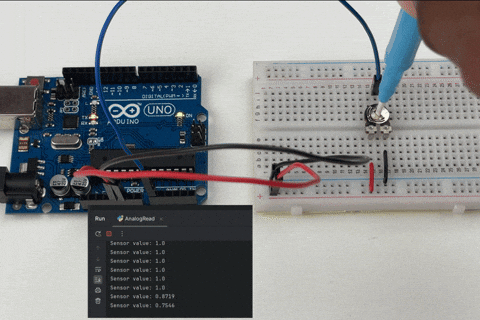
Analog Write or PWM Control:
In this example, we will control the brightness of an LED using Pulse Width Modulation (PWM) in python on Arduino. The LED is connected to digital pin 5 of the Arduino, which is capable of PWM output. PWM allows us to vary the intensity of the LED by adjusting the duty cycle of the signal.
The above image shows the correct circuit diagram. Once you have set up the circuit, connect the Arduino to your computer using a USB cable. Now, let's move on to the coding section.
We'll break down the essential parts of the code to understand how it works.
1. Setting Up the LED for PWM:
led_pin = board.get_pin('d:5:p') # Digital pin 5 as PWM outputConfigures pin 5 on the Arduino as a PWM output pin. Here’s what the parameters mean:
'd' stands for "digital."
'5' is the pin number on the Arduino.
'p' stands for "PWM," allowing the pin to output a signal with varying duty cycles.
2. Main Loop:
while True:
# Gradually increase the LED brightness from 0 to 255
for brightness in range(256):
led_pin.write(brightness / 255.0) # Set LED brightness (0 to 1.0 scale)
# time.sleep(0.01) # Small delay for a visible effect
# Gradually decrease the LED brightness from 255 to 0
for brightness in range(255, -1, -1):
led_pin.write(brightness / 255.0) # Set LED brightness (0 to 1.0 scale)
# time.sleep(0.01) # Small delay for a visible effectfor brightness in range (256): This loop gradually increases the brightness of the LED from 0 (off) to 255 (full brightness).
led_pin.write(brightness / 255.0): Sets the brightness of the LED. The write () method takes a value between 0 and 1.0, so we divide the brightness by 255.
time.sleep(0.01): (Commented out in this example) Pauses the program briefly to create a smooth fading effect. Uncomment to slow down the transition.
The second loop does the reverse, gradually dimming the LED from full brightness back to off.
Python Code to Control the Brightness of LED using PWM
from pyfirmata import Arduino, util
import time
# Establish connection to the Arduino board (replace 'COM8' with your specific port)
board = Arduino('COM8')
# Set up the LED on digital pin 5 as a PWM output
led_pin = board.get_pin('d:5:p') # Digital pin 5 as PWM output
# Start an iterator to continuously update the pin values from the Arduino
it = util.Iterator(board)
it.start()
try:
while True:
# Gradually increase the LED brightness from 0 to 255
for brightness in range(256):
led_pin.write(brightness / 255.0) # Set LED brightness (0 to 1.0 scale)
# time.sleep(0.01) # Small delay for a visible effect
# Gradually decrease the LED brightness from 255 to 0
for brightness in range(255, -1, -1):
led_pin.write(brightness / 255.0) # Set LED brightness (0 to 1.0 scale)
# time.sleep(0.01) # Small delay for a visible effect
except KeyboardInterrupt:
# Handle the program interruption by the user (Ctrl+C)
print("Program interrupted by user.")
finally:
# Safely exit the program and close the connection to the Arduino
board.exit()When you run this script, the LED will gradually fade in and out, creating a smooth pulsing effect.
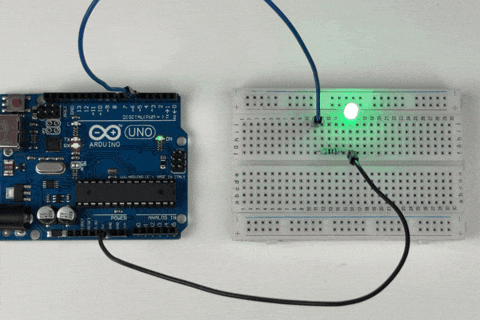
Servo Motor Control:
In this example, we'll control a servo motor using python an Arduino. The servo is connected to digital pin 9 of the Arduino. The servo motor can be rotated to a specified angle, typically between 0 and 180 degrees.
The circuit diagram above shows how to connect the servo motor to the Arduino. After wiring the circuit, connect the Arduino to your computer via a USB cable, and let's move on to the coding part.
Here's a step-by-step breakdown of the code:
1. Setting Up the Servo:
# Set the pin where the servo is connected (e.g., pin 9)
servo_pin = board.get_pin('d:9:s') # 'd' for digital, 9 is the pin number, 's' for servoConfigures pin 9 on the Arduino as a servo control pin.
'd' indicates that this is a digital pin.
'9' is the pin number.
's' stands for "servo," specifying that this pin will control a servo motor.
2. Sweeping the Servo:
while True:
# Sweep from 0 to 180 degrees
for angle in range(0, 181, 1):
servo_pin.write(angle) # Move servo to the specified angle
time.sleep(0.001) # Adjust the speed of the sweep
# Sweep back from 180 to 0 degrees
for angle in range(180, -1, -1):
servo_pin.write(angle) # Move servo to the specified angle
time.sleep(0.001)for angle in range(0, 181, 1): This loop rotates the servo from 0 to 180 degrees.
servo_pin.write(angle): Moves the servo to the specified angle.
time.sleep(0.001): Pauses the program briefly between angle changes to control the speed of the servo movement.
The second loop reverses the direction, sweeping the servo from 180 degrees back to 0.
Python Code for Controlling Arduino Servo Motor
import time
from pyfirmata import Arduino
# Change the port to the one your Arduino is connected to
board = Arduino('COM8')
# Set the pin where the servo is connected (e.g., pin 9)
servo_pin = board.get_pin('d:9:s') # 'd' for digital, 9 is the pin number, 's' for servo
def sweep_servo():
try:
while True:
# Sweep from 0 to 180 degrees
for angle in range(0, 181, 1):
servo_pin.write(angle) # Move servo to the specified angle
time.sleep(0.001) # Adjust the speed of the sweep
# Sweep back from 180 to 0 degrees
for angle in range(180, -1, -1):
servo_pin.write(angle) # Move servo to the specified angle
time.sleep(0.001)
except KeyboardInterrupt:
# Handle the program interruption by the user (Ctrl+C)
print("Sweep interrupted by user.")
finally:
# Safely exit the program and close the connection to the Arduino
board.exit()
# Run the sweep function
sweep_servo()When you run this script, the servo motor will smoothly sweep back and forth between 0 and 180 degrees.
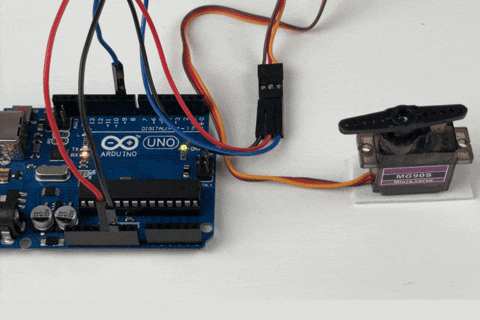
Troubleshooting Common Arduino Python Issues
Here are solutions to the most common problems when programming Arduino with Python:
Problem 1: "ModuleNotFoundError: No module named 'pyfirmata'"
Solution:
- Ensure pip is installed:
python -m pip --version - Install PyFirmata:
pip install pyfirmata - If using virtual environment, activate it first
- For Python 3.11+, use:
pip3 install pyfirmata
Problem 2: Arduino Not Responding to Python Commands
Solution:
- Verify StandardFirmata is uploaded to Arduino
- Check correct COM port selection in Device Manager
- Ensure Arduino IDE is closed (it can block the port)
- Try different USB cable or port
- Restart both Arduino and Python script
Problem 3: "Serial port not found" Error
Solution:
- Install Arduino drivers properly
- Check port name in Arduino IDE (Tools > Port)
- Update your Python code with correct port name
- On Windows: usually COM3, COM4, etc.
- On Mac/Linux: usually /dev/ttyUSB0 or /dev/ttyACM0
Problem 4: Python Script Crashes When Reading Sensors
Solution:
- Always use
util.Iteratorto continuously update pin states - Add
time.sleep()delays in your main loop - Handle
Nonevalues from sensor reads - Check sensor wiring and power supply
Problem 5: Slow Response from Arduino
Solution:
- Increase baud rate in Firmata sketch (up to 115200)
- Reduce delay times in your Python code
- Use threading for continuous sensor monitoring
- Optimize your Python code for efficiency
If you are still having problems with programming your Arduino board using Python, you can post them in the comment section below, and we will try our best to resolve them. You can also check out the "Join our community" option at the bottom of this page, where you can interact with our 100K+ readers using your preferred social media platform to ask and discuss your project ideas.
Advantages of Using Firmata:
Ease of Use: Firmata communicates between Arduino and Python, allowing you to control hardware with straightforward commands without needing to write custom firmware.
Real-Time Interaction: Firmata supports real-time data exchange, making it ideal for interactive applications where immediate feedback and control are necessary.
Cross-Platform Compatibility: Firmata is supported on various platforms, enabling you to develop and run your projects on different operating systems with minimal changes.
Rapid Prototyping: It accelerates prototyping by reducing the need for low-level code, allowing you to focus on the logic and functionality of your application.
Arduino Python vs C++: Which Should You Choose?
Many beginners wonder whether to use Python or C++ for Arduino programming. Here's a detailed comparison:
| Feature | Python + PyFirmata | Arduino C++ |
|---|---|---|
| Learning Curve | Easy - beginner friendly syntax | Moderate - requires C++ knowledge |
| Development Speed | Fast prototyping and testing | Slower development cycle |
| Performance | Good for most projects | Better for real-time applications |
| Libraries Available | Massive Python ecosystem | Arduino-specific libraries |
| Best Use Cases | Data analysis, GUI creation, web integration | Embedded systems, real-time control |
| Hardware Requirements | Requires computer connection | Standalone operation |
When to Choose Python for Arduino:
- You're new to programming and want easier syntax
- You need to integrate with databases or web services
- You want to create desktop applications with Arduino data
- You're prototyping and need rapid development
- You want to use Python's data science libraries
When to Choose C++ for Arduino:
- You need standalone Arduino operation
- You're building time-critical applications
- You want to minimize power consumption
- You need direct hardware register access
- You're building commercial products
Disadvantages of Using Firmata:
Limited Control: Firmata provides a general-purpose interface, which may not be suitable for projects requiring fine-tuned control or access to advanced features of the microcontroller.
Performance Limitation: The abstraction layer introduced by Firmata can lead to performance limitations, particularly in time-sensitive or resource-constrained applications.
Dependency on External Libraries: Using Firmata requires additional libraries, which might introduce compatibility issues or increase the complexity of managing dependencies in your project.
By considering these pros and cons, you can determine whether Firmata is the right choice for your specific project needs.
Download Python Arduino Codes from Github
All the codes discussed in this article, along with their circuit diagram, are available on our GitHub repo linked below. Under the code directory, you will find Python code for Digital Read, Digital Write, Analog Read, Analog Write, LED Blink, LED Brightness control, and servo control. By combining this basic code, you will be able to build many interesting Arduino projects.
Frequently Asked Questions
Can Arduino be programmed in Python?
Yes, Arduino can be controlled with Python using the PyFirmata library. While you can't directly write Python code to run on Arduino hardware, you can use Python to send commands to control Arduino pins, sensors, and actuators through the Firmata protocol.
Is Python better than C++ for Arduino programming?
Python offers easier syntax and faster development, making it ideal for beginners and rapid prototyping. However, C++ provides direct hardware control and better performance for complex real-time applications. Choose Python for learning and prototyping, C++ for production systems.
What is PyFirmata and how does it work?
PyFirmata is a Python library that implements the Firmata protocol, enabling communication between Python and Arduino. It allows Python to control Arduino pins and read sensor data through serial communication, acting as a bridge between Python software and Arduino hardware.
Do I need to know C++ to use Arduino with Python?
No, you don't need to know C++ to use Arduino with Python. You only need to upload the StandardFirmata sketch once (which is pre-written), then you can control everything using Python code. This makes Arduino accessible to Python developers without learning C++.
Can I use Arduino with Python wirelessly?
Yes, you can use Arduino with Python wirelessly using WiFi modules (like ESP32), Bluetooth modules, or XBee radios. The Firmata protocol supports wireless communication, allowing remote control of Arduino projects from Python scripts.
What Arduino boards work with Python and PyFirmata?
PyFirmata works with most Arduino boards including Arduino Uno, Nano, Mega, Leonardo, and ESP32. Any board that supports the Firmata protocol can be controlled with Python. Check the Firmata documentation for the latest board compatibility.
Why is my Arduino Python script running slowly?
Slow performance usually occurs due to inadequate delays in code, missing Iterator usage, or low baud rates. Ensure you're using util.Iterator, add appropriate time.sleep() delays, and consider increasing the baud rate in your Firmata sketch for faster communication.
Conclusion: Master Arduino Programming with Python
Programming Arduino with Python using PyFirmata opens up incredible possibilities for beginners and experienced developers alike. By following this comprehensive guide, you've learned how to:
- Set up Python communication with Arduino using the Firmata protocol
- Control digital and analog inputs/outputs with Python code
- Build projects involving LEDs, sensors, and servo motors
- Troubleshoot common issues in Arduino Python programming
- Decide when to use Python vs C++ for your Arduino projects
Whether you're building IoT projects, data logging systems, or interactive prototypes, the combination of Arduino's hardware capabilities with Python's extensive libraries creates endless opportunities for innovation. Start with the simple examples in this tutorial and gradually build more complex projects as you gain confidence.
Remember to explore our other Arduino projects and Python tutorials to expand your skills further!
Related Arduino Python Projects to Try Next
Now that you've mastered the basics of Arduino Python programming, here are some exciting projects to challenge yourself:
- Temperature Monitoring System: Use Python to log temperature data from Arduino sensors and create graphs
- Home Automation Dashboard: Build a Python GUI to control lights, fans, and appliances via Arduino
- Data Logger with Web Interface: Combine Python web frameworks with Arduino to create IoT data logging systems
- Robot Control Interface: Use Python to create advanced control systems for Arduino-based robots
- Real-time Sensor Dashboard: Create live data visualization using Python's matplotlib and Arduino sensors
For more inspiration, check out our Raspberry Pi projects which often combine perfectly with Arduino Python programming.













